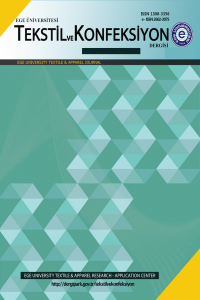ÖRMECİLİK EĞİTİMLERİNİN YAPISINA VE TEKNOLOJİSİNE YÖNELİK YENİ YAKLAŞIMLAR
Örme teknolojisi, Eğitim, VARk testi, ASSIST testi, Müfredat programı modifikasyonu
NEW APPROACHES TO STRUCTURE AND TECHNOLOGY OF KNITTING COURSES
Technology of knitting, Education, VARK test, ASSIST test, Curriculum modification,
___
- 1. Lisabon strategy, available at http://www.eu2004.ie (accessed 26 June 2006)
- 2. European Association for Quality Assurance in Higher Education, 2005, Standards and Guidelines for Assurance in the European Higher Education Area, Helsinki.
- 3. Magee, C.L., 2004, “Needs and Possibilities for Engineering Education: One Industrial/Academic Perspective”, International Journal of Engineering Education, Vol: 20(3), pp: 341-352.
- 4. Devon, R. et al., 2004, “Integrated Design: What Knowledge Is of Most Worth in Engineering Design Education?”, International Journal of Engineering Education, Vol: 20 (3), pp: 424-432.
- 5. Middleton, H., 2005, “Creative Thinking, Values and Design and Technology Education”, International Journal of Technology and Design Education, Vol: 1(15), pp: 61-71.
- 6. Sayer, K.; and Wilson, J. and Challis, S., 2006, “Problem Based Learning in Constructed Textile Design”, The International Journal of Art and Design Education, Vol: 25(2), pp. 159-163.
- 7. Ellis, G.W. and Rudnitsky, A.N. and Scordilis, G.E., 2005, “Finding Meaning in the Classroom: Learner-Centred Approaches that Engage Students in Engineering”, International Journal of Engineering Education, Vol: 21(6), pp: 1148-1158.
- 8. Marton, F. and Säljö, R., 1976, “On Qualitative Differences in Learning: I Outcome and Process”, British Journal of Educational Psychology, Vol: 46(1), pp: 4-11.
- 9. Biggs, J., 2003, Teaching for Quality Learning at University, The Society for Research in Higher Education, Open University Press, Berkshire.
- 10. Prosser, M. and Trigwell, K., 1999, Understanding Learning and Teaching, Society for Research in Higher Education, Open University Press, Berkshire.
- 11. Ramsden, P., 1992, Learning to Teach in Higher Education, Routledge, London.
- 12. Multiple Intelligence Inventory available at http://www.ldrc.ca/projects/miinventory/mitest.html (accesed 09 Juni 2008).
- 13. Paragon Learning Style Inventory available at http://www.oswego.edu/plsi/plsi48a.htm (accessed 09 Juni 2008).
- 14. Learning Styles Questionnaire available at http://www.peterhoney.com/content/tools.html (accessed 09 Juni 2008).
- 15. Fleming, N.D., 1996, VARK, Lincoln University, New Zealand.
- 16. Tait, H. and Entwistle, N.J. and McCune, V., 1998, “ASSIST: a Reconcemptualisation of the Approaches to Studying Inventory”, Improving Student Learning, Oxford Centre for Staff and Learning Development, Oxford, pp: 262-271.
- 17. Salopek, I.; Potočić Matković, V.M.; Vrljičak, Z.; Srdjak, M., 2006, “Design of Socks in the Past and Present”, Book of Proceedings of the 3 rd International Textile, Clothing and Design Conference “Magic World of Textiles”, 08-11th October 2006, Dubrovnik, Croatia, pp: 893- 897.
- 18. Srdjak, M.; Potocic Matkovic, V.M.; Pavko Cuden, A., 2006, “Understanding a Designer Technologist Team Work”, Proceedings of 3rd International Textile, Clothing & Design Conference, 8-11 October 2006, Dubrovnik, Croatia.
- 19. Entwistle, N.J.; Ramsden, P., 1983, Understanding Student Learning, Croom Helm, London.
- 20. The VARK Questionnaire for younger people, available at http://student.mwcc.edu/VARK/questionnaire_y.asp (accessed 09 Juni 2008).
- ISSN: 1300-3356
- Yayın Aralığı: Yılda 4 Sayı
- Başlangıç: 1991
- Yayıncı: Ege Üniversitesi
GELENEKSEL OLMAYAN KARIŞIMLARDAN YAPILAN KUMAŞLARDA SÜRTÜNME KATSAYISININ ANALİZİ
Mário LİMA, Rosa M. VASCONCELOS, Luís F. SİLVA, Joana CUNHA
2007 YILI TEKSTİL İŞLETMELERİNİN FİNANSAL KARLILIK AÇISINDAN ETKİNLİKLERİNİN DEĞERLENDİRMESİ
PAMUKLU ÖRME KUMAŞLARDA HAVA GEÇİRGENLİĞİNİN İNCELENMESİ VE İSTATİSTİKSEL OLARAK TAHMİNLENMESİ
Serin MAVRUZ, R. Tuğrul OĞULATA
METAL İPLİK İÇEREN DOKUMA KUMAŞLARIN PERFORMANS ÖZELLİKLERİNİN İNCELENMESİ
Pınar DURU BAYKAL, Neslihan SIĞNAK
YÜN TERBİYESİNDE OZONLA İŞLEMİN BEYAZLIK DERECESİNE ETKİSİNİN ARAŞTIRILMASI
Tülay GÜLÜMSER, Candan AKÇA, M. İbrahim BAHTİYARİ
Seher PERİNCEK, Kerim DURAN, Ayşegül E. KÖRLÜ, M. İbrahim BAHTİYARİ
Necla YAMAN, Esen ÖZDOGAN, İ.Cengiz KOCUM, Hakan AYHAN, Tülin ÖKTEM, Necdet SEVENTEKIN
